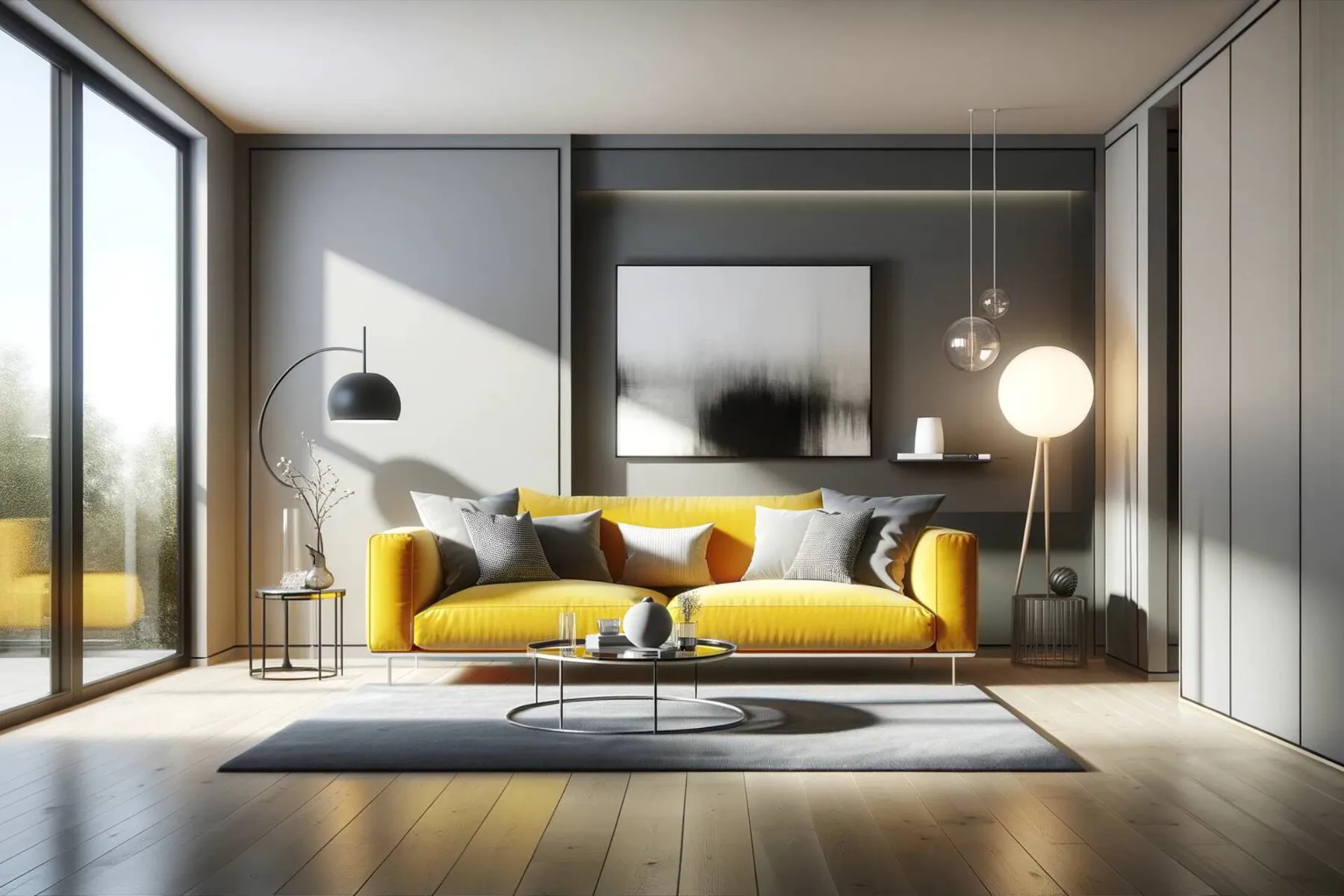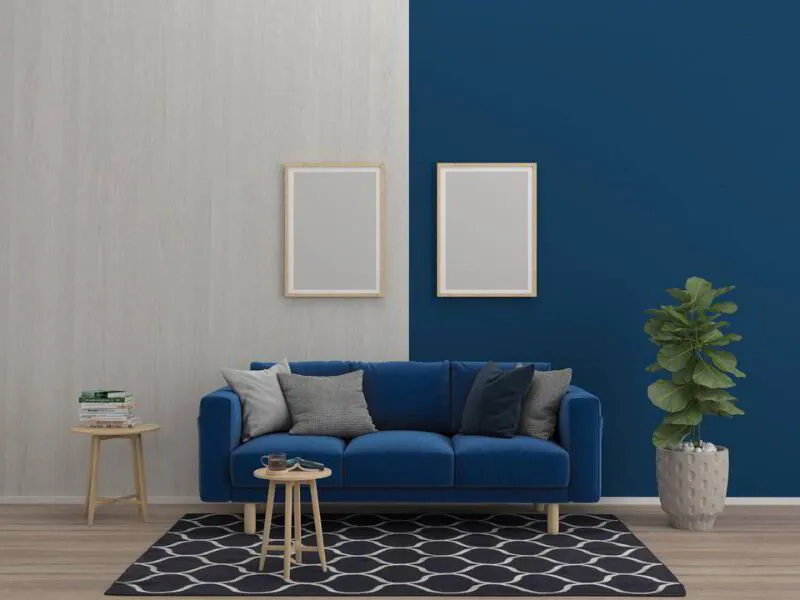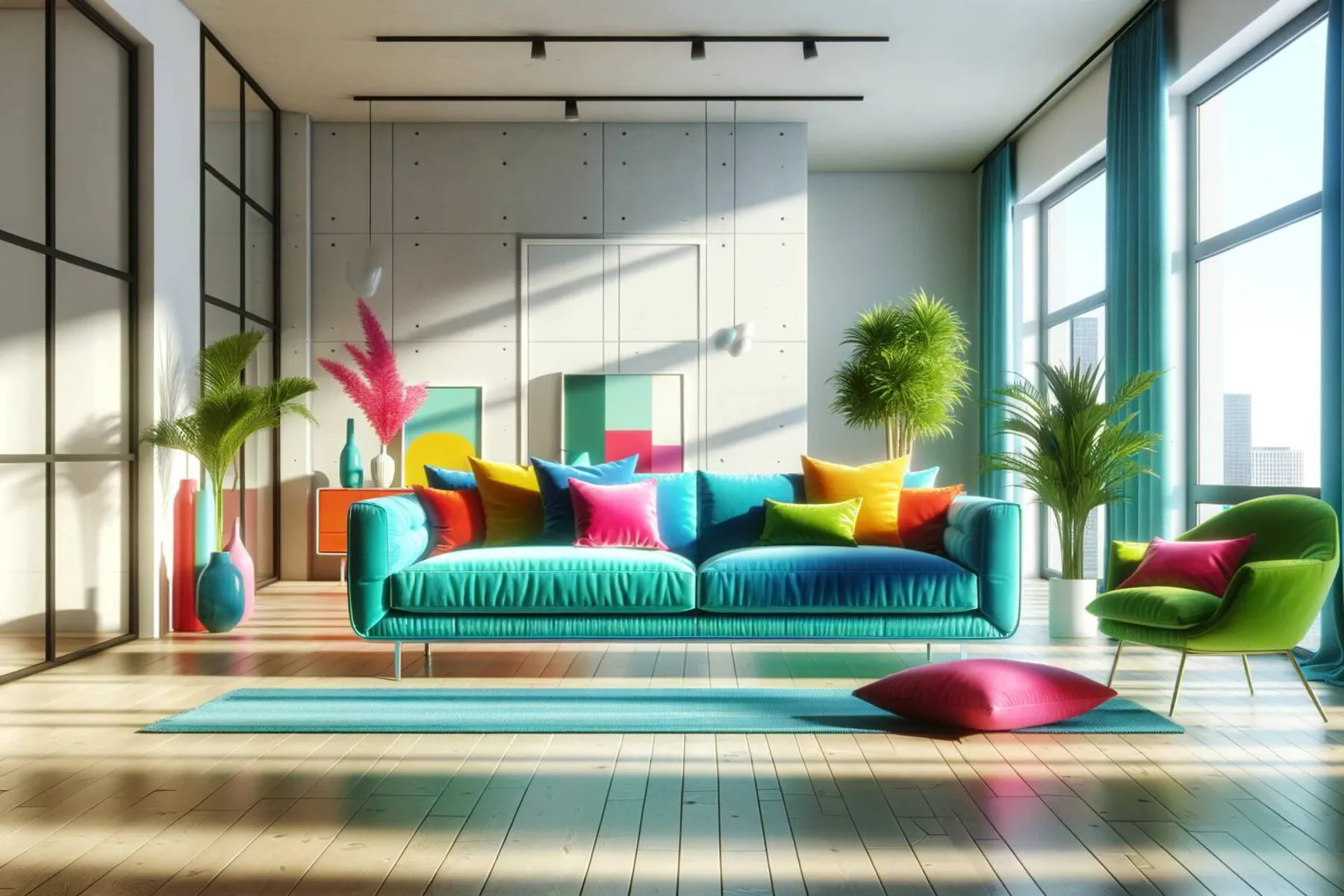In interior design, emphasis is crucial in creating visually appealing and harmonious spaces. Interior designers can draw attention to specific areas or objects using various techniques and elements, adding depth and character to a room.
Understanding the principle of emphasis is vital for creating impactful and aesthetically pleasing interiors. When designing a space, it is essential to consider how the viewer's attention will be guided.
📘 Key Takeaways
- Critical Role of Emphasis: Emphasis is vital in interior design for creating visually appealing and harmonious spaces. It guides the viewer's attention, sets the room's tone, and highlights key design features.
- Techniques for Creating Emphasis: Designers use color, scale, texture, lighting, and strategic arrangement to create emphasis. Bold colors attract attention, while scale and proportion influence visual hierarchy. Textures add depth, and lighting accentuates focal points.
- Impact of Furniture and Decor: Furniture choices, like bold-colored sofas or unique pieces, and decor elements, such as artwork or plants, play a significant role in creating emphasis and setting the room's tone.
- Balancing Emphasis with Harmony: While emphasis is crucial, it's essential to maintain balance and harmony within the design to avoid overwhelming the viewer and ensure a cohesive aesthetic.
- Emphasis Across Design Styles and Technological Integration: Emphasis varies in different interior design styles, such as modern, traditional, or eclectic. Advanced technology and sustainable practices are increasingly integrated to enhance emphasis in design.
Harnessing Color for Emphasis In Interior Design
One of the critical aspects of emphasis is the use of color. Colors can evoke emotions and create a sense of hierarchy within a design.
Bright and bold colors tend to attract attention, while muted and neutral colors can make a more subtle emphasis. For example, in a room with neutral tones, a single vibrant accent color can draw the viewer's eye and create a focal point.
📘 Related Reading: How To Use Color Theory For Interior Design
Leveraging Scale and Proportion
Another way to create emphasis is through the use of scale and proportion. By varying the size of elements within a design, designers can develop a sense of importance and hierarchy.
Larger pieces tend to command attention, while more minor elements can be used to support and complement the focal point. For instance, smaller decorative objects can be strategically placed in a room with a large statement artwork to enhance its significance.
📘 Related Reading: How to Use Proportion and Scale in Interior Design
The Power of Texture in Design
Texture is also a powerful tool for creating emphasis. Different textures can add depth and visual interest to a design, drawing attention to specific elements.
Rough and textured surfaces tend to stand out, while smooth and sleek surfaces can create a more subdued emphasis. For example, in a room with a textured accent wall, the viewer's attention will naturally be drawn to that area, creating a focal point.
📘 Related Reading: How to Use Texture in Interior Design for Maximum Impact
Illuminating Spaces: The Role of Lighting
Furthermore, the use of lighting can significantly enhance emphasis within a space. By highlighting specific areas or objects with lighting, designers can guide the viewer's gaze and create a focal point.
Whether through spotlights, track lighting, or even natural light, the strategic placement of light sources can significantly impact the emphasis within a design.
📘 Related Reading: The Magic of Interior Lighting Design: A Complete Guide
Strategic Space Planning for Emphasis
Lastly, the placement and arrangement of elements within a space can also contribute to emphasis.
By carefully positioning elements within negative space, designers can create a visual flow that leads the viewer's eye toward the focal point. For instance, in a room with a fireplace as the focal point, furniture can be arranged to direct attention toward it, creating a sense of emphasis.
Multiple focal points become crucial in larger or more complex layouts. Managing many focal points involves balancing different areas of interest without overwhelming the viewer.
For example, in a spacious living room, a designer might create a primary focal point around a large artwork and a secondary one around a cozy reading nook.
These multiple focal points should harmoniously coexist, guiding the viewer's gaze through the space and creating a dynamic yet cohesive interior.
📘 Related Reading: The Benefits of Good Space Planning in Interior Design
The Art of Emphasis in Design
Overall, emphasis is a crucial principle in design that helps guide the viewer's attention and create visual interest.
Through color, scale, texture, lighting, and arrangement, designers can strategically emphasize within a space, enhancing its overall aesthetic and visual appeal.
Understanding Emphasis in Interior Design
Emphasis involves creating a focal point or center of interest in a space. This point is the anchor for the viewer's eyes and sets the tone for the entire design.
It can be achieved through different visual cues like scale, color, texture, and contrast. When used harmoniously, these elements create a sense of balance and proportion within the space.
The Role of Design Principles in Creating Emphasis
To create emphasis, it is crucial to understand the principles and elements of design thoroughly. By manipulating these factors, interior designers can create a compelling and engaging space that reflects the intended atmosphere and purpose.
Utilizing Scale for Emphasis
Scale is one of the critical elements that can be utilized to create emphasis. By playing with the size of objects and elements within a space, designers can draw attention to specific areas.
For example, a significant statement artwork hanging above the fireplace in a living room can become the focal point. Its size and placement demand attention, making it the center of interest.
The Impact of Color in Emphasis
Color is another powerful tool in creating emphasis. By using bold and contrasting colors, designers can guide the viewer's eyes to specific areas.
For instance, in a minimalist bedroom, a vibrant red accent on one wall can become the focal point, drawing attention and adding a sense of drama to the space.
Texture as a Tool for Emphasis
Texture is yet another element that can be employed to create emphasis. By incorporating different textures within a room, designers can add visual interest and draw attention to specific areas.
For example, a textured backsplash made of patterned tiles can become in a contemporary kitchen point in a modern kitchen, adding depth and character to the overall design.
Using Contrast to Create Emphasis
Contrast, both in terms of color and materials, can also be utilized to create emphasis. By juxtaposing light and dark, smooth and rough, or shiny and matte surfaces, designers can create visual tension and direct the viewer's focus.
For instance, a sleek white bathtub against a dark, textured modern bathroom in a contemporary bathroom can become the focal point, creating a striking visual contrast.
The Importance of Design Principles in Emphasis
Understanding the principles and elements of design is essential for interior designers to create emphasis within a space effectively.
By skillfully manipulating scale, color, texture, and contrast, designers can guide the viewer's attention and create a captivating environment that leaves a lasting impression.
Techniques to Create Emphasis
Regarding interior design, several techniques can be employed to create emphasis and make architectural elements in a space stand out. These techniques draw attention to specific elements and add depth and character to the overall design.
1. Point of Focus
One effective way to create emphasis is by selecting a specific element as the room's focal point. This element can be anything that captures attention, such as a unique piece of furniture, an eye-catching artwork, or even an existing focal point of an architectural feature.
By strategically placing this focal point, designers can direct the viewer's attention and create a sense of visual interest.
For example, imagine walking into a living room where a stunning, oversized chandelier hangs in the center. The grandeur and elegance of the chandelier immediately become the focal point, drawing everyone's gaze upward and setting the tone for the entire space.
2. Contrast
Another technique that designers use to create emphasis is through contrast. Designers can make certain areas or objects stand out by using contrast emphasis or juxtaposing elements with opposing characteristics. This contrast can be achieved through various means, such as color, texture, or even size.
For instance, imagine a minimalist bedroom with a predominantly white color scheme. To create emphasis, the designer might place a dark-colored, statement piece of furniture against one of the walls.
This stark contrast between the light-colored wall and the dark furniture instantly draws attention to that specific area, making it a focal point.
3. Scale and Proportion
Altering the size and proportions of elements within a space is another technique designers use to create emphasis. By playing with scale, designers can manipulate the visual weight of certain elements and make them stand out.
Consider a dining room where a long, rectangular table is the centerpiece. To create emphasis, the designer might place oversized, dramatic pendant lights directly above the table. The large pendant light provides ample light, adds a sense of grandeur, and draws attention to the dining area.
On the other hand, in a cozy reading nook, a designer might opt for a small, understated side table with a unique shape or texture. This small but distinctive element can create subtle emphasis and add an element of surprise and interest to the space.
By employing these techniques, interior designers can create emphasis within a space, making it visually captivating and engaging.
Whether through a carefully chosen focal point, a striking contrast, decorative accents, or a play with scale and proportion, these design strategies can transform any room into a truly remarkable and memorable space.
The Role of Furniture and Decor in Emphasis
Furniture and decor play a vital role in creating emphasis within a space. These elements can be strategically placed to draw attention and create a focal point.
For example, a unique and eye-catching piece of furniture can become the centerpiece of a room and set the tone for the overall design. Similarly, carefully selected decor items such as artwork, sculptures, or plants can add visual interest and create emphasis within a space.
Impact of Furniture on Room Emphasis
Regarding furniture, the choice of materials, colors, and shapes can significantly impact the level of emphasis in a room.
For instance, a bold and vibrant-colored sofa can instantly become the focal point of a living room, while a sleek and modern coffee table can draw attention in a minimalist space.
The size and scale of furniture also play a significant role in creating emphasis. A large statement piece can command attention and become the highlight of a room, while smaller furniture items can be strategically placed to guide the eye and create a sense of flow.
Decor as a Tool for Emphasis In Interior Design
Decor items, on the other hand, offer endless opportunities for creating emphasis within a space. Artwork, for instance, can be used to draw attention to a specific area or wall.
A large, striking painting can become the focal point of a room, while a gallery wall can create a sense of visual interest and emphasize a particular theme or style.
Sculptures and other three-dimensional decor pieces can also be strategically placed to create emphasis. Placing a sculpture on a pedestal or in a niche can instantly draw attention and add a sense of drama to a space.
Utilizing Plants for Visual Emphasis
Real and artificial plants are another powerful tool for creating emphasis. A tall, lush plant placed in a corner can draw the eye upwards and add height to a room.
On the other hand, a cluster of small plants arranged on a shelf or table can create a focal point and add a touch of natural beauty. The plant species' choice and placement within a space can also contribute to the overall emphasis.
For example, a vibrant flowering plant can instantly become the center of attention, while a collection of succulents can create a visually striking display.
The Transformative Power of Furniture and Decor
In conclusion, furniture and decor are essential to creating emphasis within a space. By carefully selecting and placing these items, designers can guide the eye, create focal points, and add visual interest to a room.
Whether it's the accent walls, a statement piece of furniture, a striking artwork, or a cluster of plants, these elements can transform a space and make it truly captivating.
Color and Lighting: Enhancing Emphasis
Color and lighting are essential elements in interior design and powerful tools for enhancing emphasis and creating a captivating atmosphere.
When used strategically, these elements can transform a space, drawing attention to specific areas and creating a visual hierarchy that guides the viewer's gaze.
The Power of Bold and Contrasting Colors
One of the most effective ways to create emphasis through color is by utilizing bold and contrasting hues. Vibrant colors, such as fiery reds or electric blues, can instantly capture the eye and make a statement.
By strategically incorporating these bold colors into a room, designers can draw attention to specific architectural features, furniture pieces, or decorative elements.
For example, a vibrant red accent wall can be a focal point in a living room, instantly grabbing attention and creating a sense of drama.
Utilizing Muted Tones for Subtle Emphasis
On the other hand, softer and more muted tones can also play a crucial role in creating emphasis. These understated colors can develop a sense of harmony and balance, allowing other elements in the room to use a neutral color palette as a backdrop.
Designers can highlight specific objects or areas with ads of contrasting colors. For instance, a room with a predominantly neutral color scheme can feature a vibrant orange armchair, instantly drawing attention to that particular seating area and making it a focal point.
Lighting Techniques to Enhance Emphasis
Lighting is another essential aspect of enhancing emphasis in interior design. By using various lighting techniques, designers can manipulate the perception of space and guide the viewer's attention.
Focused or directional lighting, such as track lighting or spotlights, can highlight specific objects or architectural details.
For example, a spotlight can be directed toward a beautiful artwork, instantly making it the center of attention and adding a touch of sophistication to the room.
Ambient Lighting for Subtle Emphasis
In addition to focused lighting, ambient lighting can create more subtle and indirect emphasis.
Soft and diffused lighting, such as recessed lighting or wall sconces, can create a warm and inviting atmosphere while gently illuminating the entire space.
This type of lighting can be particularly effective in highlighting specific areas, such as a cozy reading nook or a dining table, without overpowering the overall ambiance.
The Synergy of Color and Lighting in Design
When enhancing emphasis in interior design, color and lighting are two powerful tools that should not be overlooked.
By carefully selecting and combining different colors and lighting techniques, designers can create a visually stunning and captivating space that captures the attention and imagination of anyone who enters.
Balancing Emphasis with Harmony
While emphasis is essential in interior design, it should be balanced with the overall harmony and unity of the space. Too much emphasis can create visual chaos and overwhelm the viewer.
Achieving a balance between emphasis and harmony ensures the design remains cohesive and visually pleasing.
Emphasis in Different Interior Design Styles
The concept of emphasis can be applied to various interior design styles, including:
- Modern: In modern design, emphasis is often achieved through clean lines, bold colors, and minimalist decor.
- Traditional: Emphasis on traditional design can be created through ornate furniture, rich textures, and intricate detailing.
- Eclectic: Emphasis in eclectic design is achieved through a mix of styles, colors, and patterns, creating visual interest and a sense of uniqueness.
Technology and Emphasis in Interior Design
As technology advances, it is increasingly being integrated into interior design. From smart home automation to innovative lighting solutions, technology can enhance emphasis in interior spaces.
For example, smart lighting systems can be programmed to highlight specific areas or objects, adding an extra layer of emphasis.
Psychological and Cultural Dimensions of Emphasis
The concept of emphasis in interior design also holds psychological and cultural significance. Different cultures perceive emphasis differently, and designers must consider cultural preferences and sensitivities when creating focal points.
Additionally, understanding the psychological impact of emphasis can help designers create spaces that evoke specific emotions or moods.
Sustainability and Technological Integration
In today's world, sustainability plays a crucial role in interior design. Emphasis can be achieved through sustainable practices and the use of eco-friendly materials.
Additionally, technology can be harnessed to create sustainable and energy-efficient spaces, further enhancing emphasis through responsible design choices.
Practical Application
Applying the principle of emphasis in interior design requires careful consideration and planning. Designers must analyze the space, function, and desired atmosphere before determining the focal point and selecting appropriate elements.
By sketching and creating mood boards, designers can visualize the final design and ensure the placement of emphasis aligns with the overall vision.
Conclusion
The principle of emphasis is a powerful tool in interior design, allowing designers to create visually striking and harmonious spaces.
By understanding the techniques and elements used to create emphasis, designers can guide the viewer's attention and create a memorable experience within a space.
Through color, scale, or furniture placement, emphasis adds depth and character, elevating interior design to new heights.
📘 Related Reading: Top 30 Home Interior Design Ideas For A Fresh Look
Lara Harding
Lara is a supporting author @ DIY Home Comfort. She's an experienced interior designer and decorator and a full-time mom. You can find out more about her here.
Frequently Asked Questions
How does emphasis affect interior design?
Emphasis in interior design guides the viewer's eye to focal points, creating visual interest and balance. It highlights key design features, sets the room's mood, and shapes the aesthetic experience.
Why is emphasis important in interior design?
Emphasis in interior design is crucial for directing attention to key design elements, creating a focal point, enhancing aesthetic appeal, and establishing a room's character and mood.
What is an example of emphasis in interior design?
An example of emphasis in interior design is a brightly colored accent wall in a neutral room, drawing immediate attention and creating a visual focal point.
How do you create emphasis when designing a room?
To create emphasis in room design, use standout elements like bold colors, unique textures, distinctive lighting, or statement furniture strategically placed to draw attention and create a focal point.
What effect does emphasis have?
Emphasis in design draws attention to critical elements, creating focal points that guide the viewer's eye, enhance visual interest, and establish a space's mood and character.
In what ways can emphasis be created in a design?
Emphasis in design can be created using contrasting colors, unique textures, distinctive lighting, scale variation, bold patterns, or focal furniture pieces strategically placed to draw the viewer's attention.






